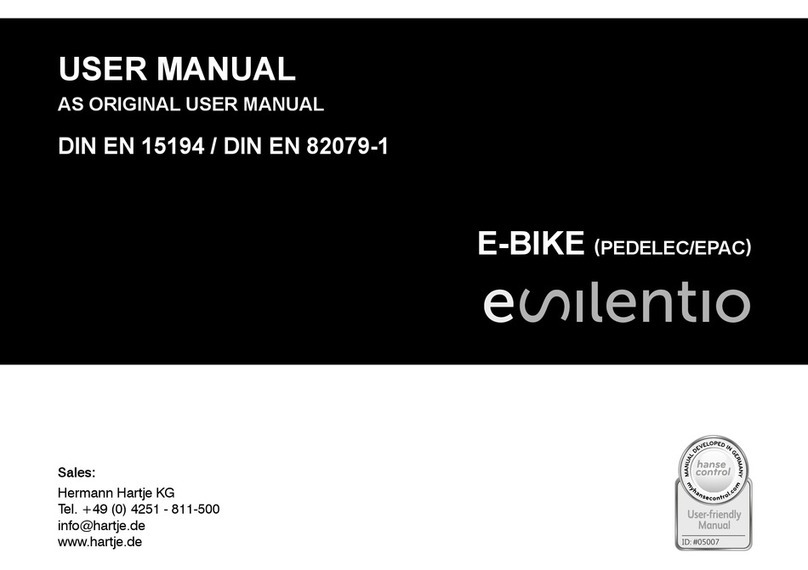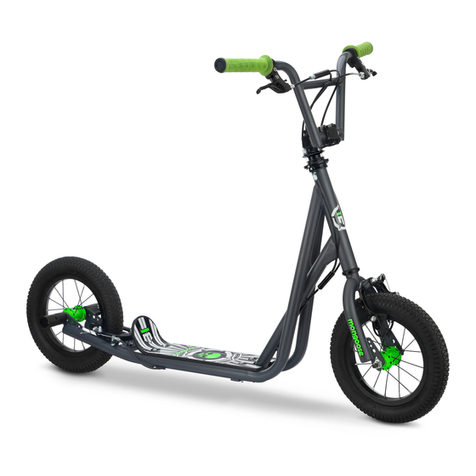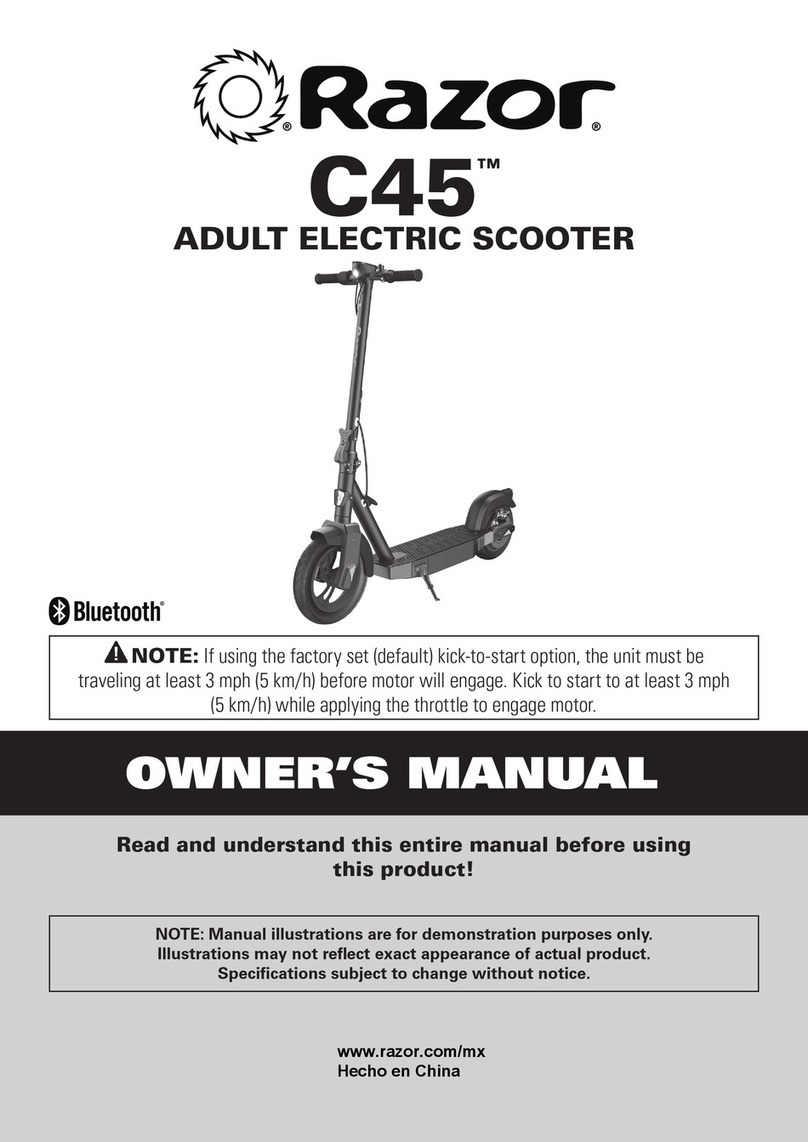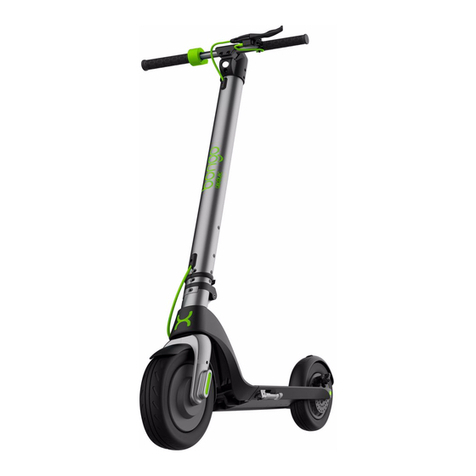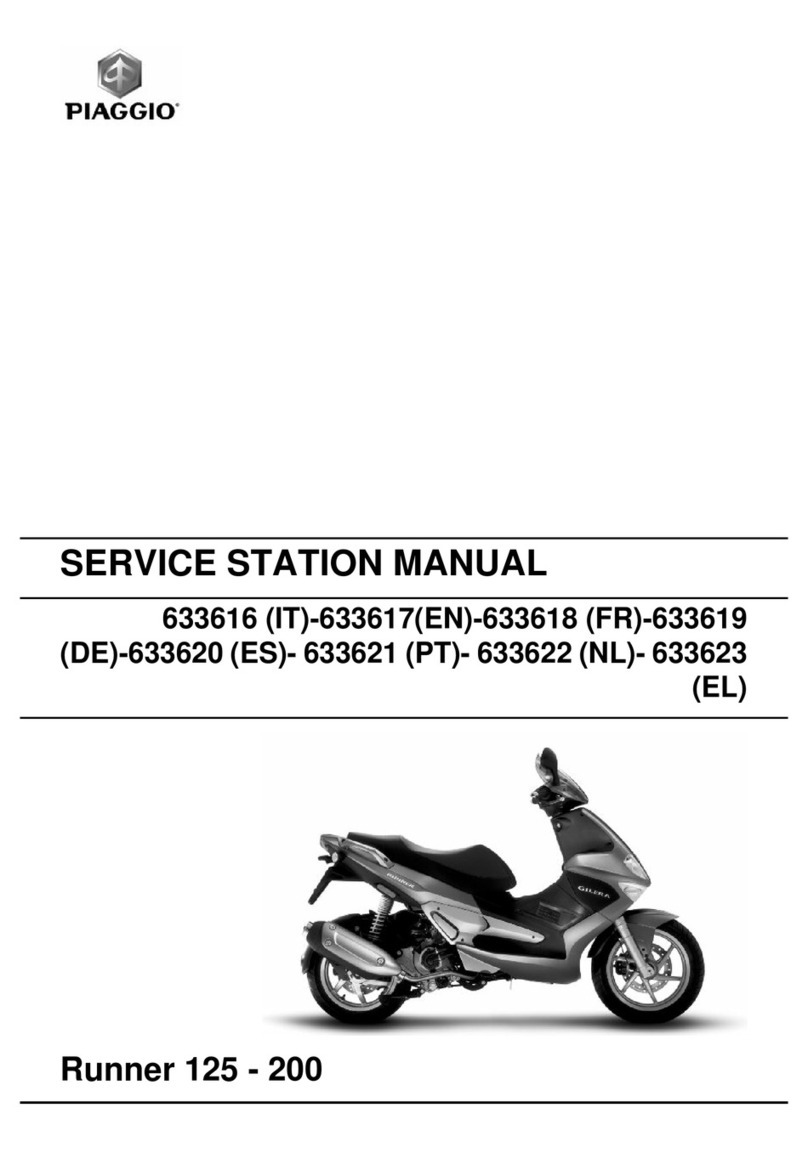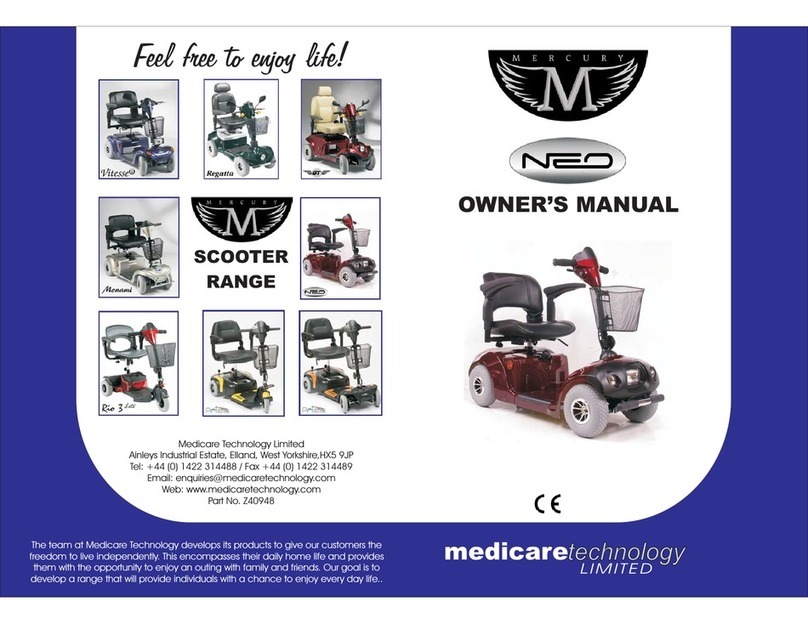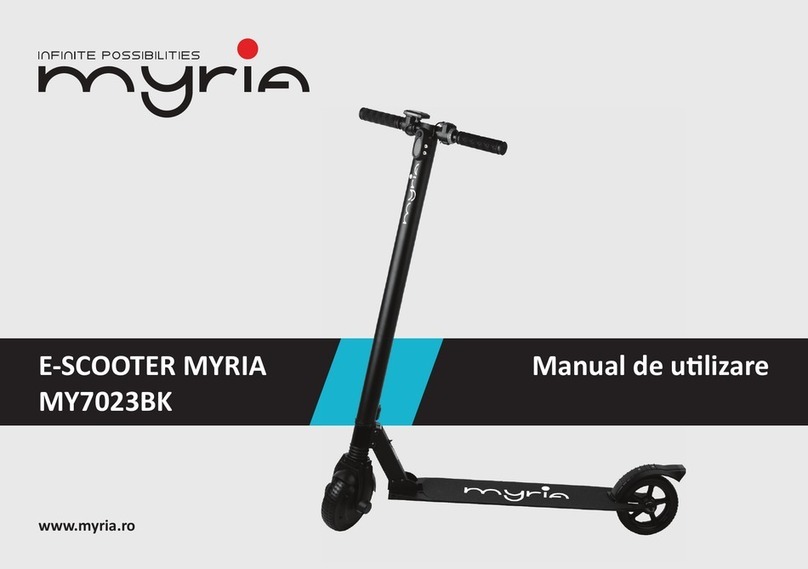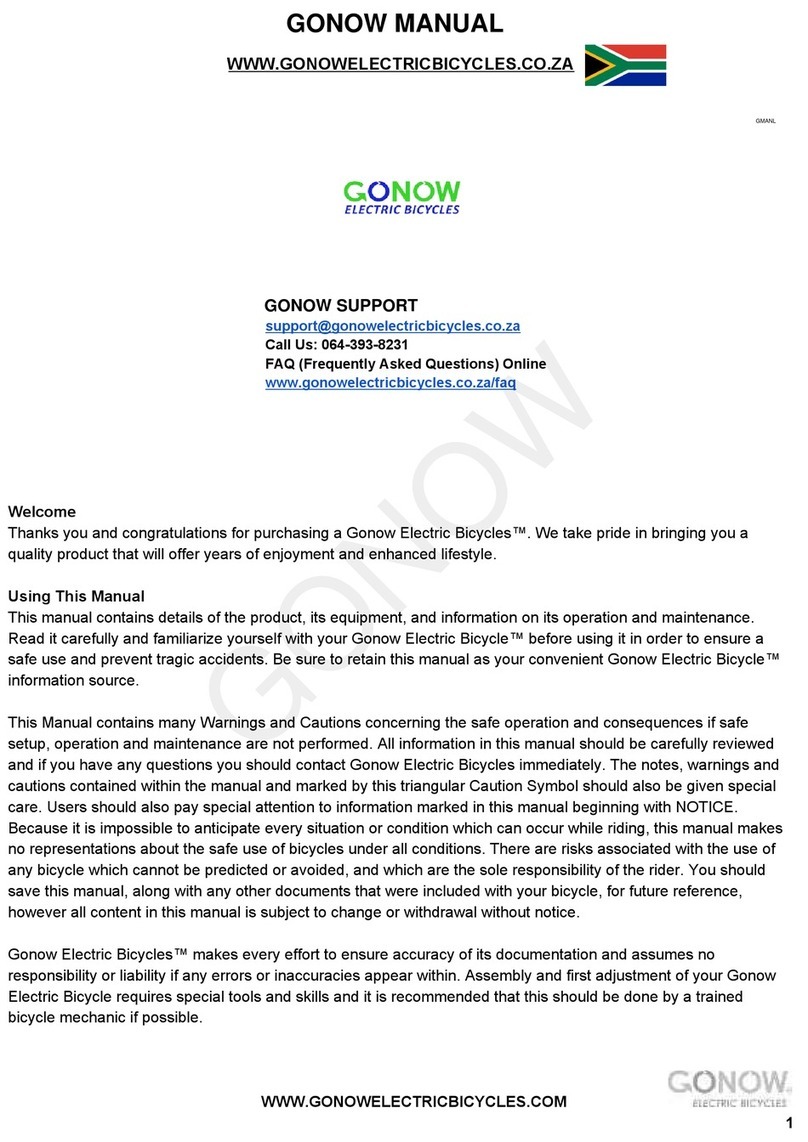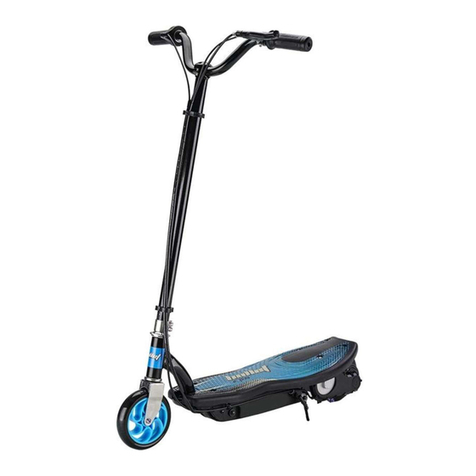HARTJE Road Cruiser E Damen User manual

Sales:
Hermann Hartje KG
Tel: +49 (0)4251 811 90
www.hartje.de
USER MANUAL
AS THE ORIGINAL OPERATING MANUAL
DIN EN 15194 / DIN EN 82079-1
E-BIKE (PEDELEC/EPAC)


3
E-bike components
1 E-bike components
The figure may vary depending on your e-bike model or the
selected configuration. Read the special notes regarding your
configuration in the respective chapters.
Familiarise yourself with the operation and functions, as well as the
care and maintenance instructions.
Control unit
Rechargeable battery
with indicator
Charger
Drive
KM/H
KM
ODO

4
Table of contents
1 E-bike components. . . . . . . . . . . . . . . . . . . . . . .3
2 In an emergency. . . . . . . . . . . . . . . . . . . . . . . . .7
2.1 General protective measures . . . . . . . . . . . . . . . 7
2.2 In the event of excessive heat . . . . . . . . . . . . . . 7
2.3 In the event of deformation, odour, liquid . . . . . . 7
2.4 If the rechargeable battery catches fire . . . . . . . 8
3 Tuning or manipulations . . . . . . . . . . . . . . . . . . .8
4 Safety notes . . . . . . . . . . . . . . . . . . . . . . . . . . . .9
4.1 Usage safety notes . . . . . . . . . . . . . . . . . . . . . . . 9
4.2 Road traffic safety notes. . . . . . . . . . . . . . . . . . 10
4.3 Charger safety notes . . . . . . . . . . . . . . . . . . . . 10
4.4 Rechargeable battery safety notes . . . . . . . . . .12
4.5 Residual risks . . . . . . . . . . . . . . . . . . . . . . . . . . .13
5 Basic information . . . . . . . . . . . . . . . . . . . . . . .13
5.1 Reading and keeping the user manual . . . . . . . . .13
5.2 Warning notes . . . . . . . . . . . . . . . . . . . . . . . . . 14
5.2.1 Structure . . . . . . . . . . . . . . . . . . . . . . . . . . . . . . . 14
5.2.2 Categorisation of warning notes . . . . . . . . . . . . . 14
5.3 Proper use . . . . . . . . . . . . . . . . . . . . . . . . . . . . 15
5.4 Symbols on the products . . . . . . . . . . . . . . . . . 15
5.5 Terms . . . . . . . . . . . . . . . . . . . . . . . . . . . . . . . . 15
5.6 Units . . . . . . . . . . . . . . . . . . . . . . . . . . . . . . . . . 16
5.7 Differences between a bicycle and an e-bike. . .17
5.8 Functionality . . . . . . . . . . . . . . . . . . . . . . . . . . . .17
5.8.1 Range. . . . . . . . . . . . . . . . . . . . . . . . . . . . . . . . . . 17
5.8.2 Cycling with an empty rechargeable battery . . . . 18
5.8.3 Drive overheat protection . . . . . . . . . . . . . . . . . . 18
5.9 Road traffic . . . . . . . . . . . . . . . . . . . . . . . . . . . . 19
5.10 Lights . . . . . . . . . . . . . . . . . . . . . . . . . . . . . . . 19
5.11 Permissible total weight . . . . . . . . . . . . . . . . . 19
5.12 Transport. . . . . . . . . . . . . . . . . . . . . . . . . . . . . 20
5.12.1 E-bike . . . . . . . . . . . . . . . . . . . . . . . . . . . . . . . . . 20
5.12.2 By car . . . . . . . . . . . . . . . . . . . . . . . . . . . . . . . . . 20
5.12.3 Using other forms of transportation . . . . . . . . . . 20
5.12.4 Shipping . . . . . . . . . . . . . . . . . . . . . . . . . . . . . . . 20
5.12.5 Rechargeable battery . . . . . . . . . . . . . . . . . . . . 20
5.13 Notes. . . . . . . . . . . . . . . . . . . . . . . . . . . . . . . . 21

5
Table of contents
5.13.1 Applications of the rechargeable battery
and charger . . . . . . . . . . . . . . . . . . . . . . . . . . . . . 21
5.13.2 Insurance . . . . . . . . . . . . . . . . . . . . . . . . . . . . . . 21
5.13.3 Exclusion of expendable parts. . . . . . . . . . . . . . 21
5.13.4 Disclaimer . . . . . . . . . . . . . . . . . . . . . . . . . . . . . 21
5.14 Before each ride . . . . . . . . . . . . . . . . . . . . . . . 21
5.15 Before your first ride . . . . . . . . . . . . . . . . . . . . 21
5.16 Your first ride. . . . . . . . . . . . . . . . . . . . . . . . . . 22
6 Operation . . . . . . . . . . . . . . . . . . . . . . . . . . . . .22
6.1 Charger. . . . . . . . . . . . . . . . . . . . . . . . . . . . . . . 22
6.1.1 Preparing the charger. . . . . . . . . . . . . . . . . . . . . . 22
6.1.2 Indicators on the charger . . . . . . . . . . . . . . . . . . . 23
6.1.3 Applications of the charger and
rechargeable battery . . . . . . . . . . . . . . . . . . . . . . 23
6.2 Rechargeable battery. . . . . . . . . . . . . . . . . . . . 23
6.2.1 Preparing the rechargeable battery. . . . . . . . . . . 24
6.2.2 Protective device . . . . . . . . . . . . . . . . . . . . . . . . . 24
6.2.3 Removing the rechargeable battery . . . . . . . . . . 24
6.2.4 Inserting the rechargeable battery . . . . . . . . . . . 25
6.2.5 Charge status indicator on the
rechargeable battery . . . . . . . . . . . . . . . . . . . . . . 25
6.2.6 Checking the battery charge level . . . . . . . . . . . . 26
6.2.7 Sleep mode . . . . . . . . . . . . . . . . . . . . . . . . . . . . . 26
6.2.8 Connecting the battery to the charger. . . . . . . . . 26
6.2.9 Charging the battery . . . . . . . . . . . . . . . . . . . . . . 27
6.2.10 Ending the charging process . . . . . . . . . . . . . . . 27
6.2.11 Charging times . . . . . . . . . . . . . . . . . . . . . . . . . . 28
6.2.12 Cycling with an empty rechargeable battery . . . 28
6.2.13 Storing the rechargeable battery . . . . . . . . . . . . 28
6.3 Control unit . . . . . . . . . . . . . . . . . . . . . . . . . . . . 29
6.3.1 Control unit button functions . . . . . . . . . . . . . . . . 29
6.3.2 Switching on/off the e-bike . . . . . . . . . . . . . . . . . 29
6.3.3 Reading the charge status indicator . . . . . . . . . . 30
6.3.4 Setting the level of assistance . . . . . . . . . . . . . . . 30
6.3.5 Drive overheat protection . . . . . . . . . . . . . . . . . . 31
6.3.6 Activating/deactivating the lighting . . . . . . . . . . . 31
6.3.7 Using walk assistance . . . . . . . . . . . . . . . . . . . . . 32
6.3.8 Viewing ride information . . . . . . . . . . . . . . . . . . . 32
6.3.8.1 Resetting values. . . . . . . . . . . . . . . . . . . . . . . . . . . 32

6
Table of contents
6.4 Storing the e-bike . . . . . . . . . . . . . . . . . . . . . . . 33
7 Cleaning and maintenance. . . . . . . . . . . . . . . .33
8 Disposal . . . . . . . . . . . . . . . . . . . . . . . . . . . . . .34
8.1 Disposing of the e-bike . . . . . . . . . . . . . . . . . . . 34
8.2 Disposing of rechargeable batteries and chargers .34
8.3 Disposing of the packaging . . . . . . . . . . . . . . . 34
9 Troubleshooting . . . . . . . . . . . . . . . . . . . . . . . .35
9.1 Troubleshooting the electric drive system. . . . . 35
9.2 Troubleshooting the e-bike. . . . . . . . . . . . . . . . 35
9.3 Troubleshooting the charger. . . . . . . . . . . . . . . 36
10 Technical specifications . . . . . . . . . . . . . . . . . 37
10.1 Lights . . . . . . . . . . . . . . . . . . . . . . . . . . . . . . . 37
10.2 Drive unit . . . . . . . . . . . . . . . . . . . . . . . . . . . . 37
10.3 Rechargeable battery. . . . . . . . . . . . . . . . . . . 37
10.4 Charger. . . . . . . . . . . . . . . . . . . . . . . . . . . . . . 37
11 Declaration of conformity . . . . . . . . . . . . . . . .38
12 Legal notice . . . . . . . . . . . . . . . . . . . . . . . . . .39

7
In an emergency
2 In an emergency
You can find notes on handling the rechargeable battery in this
user manual. Despite compliance with all safety measures, the
rechargeable battery may pose a risk, e.g. if it catches fire (see
Chapter “Residual risks” on page 13).
• In an emergency, act in such a way that you do not at any time
endanger yourself or other persons.
• In an emergency, follow the instructions on this page.
• Immediately read these instructions so that you can concen-
trate and respond in a calculated manner in the event of an
emergency.
• We recommend keeping a suitable fire extinguisher readily
available at all times.
2.1 General protective measures
If you identify defects or damage to the rechargeable battery:
1. Do not use the rechargeable battery.
2. Wear protective gloves when you touch the rechargeable
battery.
3. Do not inhale any gases or vapours that are emitted.
4. Avoid contact between your skin and any liquid that is
leaked.
2.2 In the event of excessive heat
If you notice that excessive heat is being generated by the
rechargeable battery:
1. Have the rechargeable battery checked by your specialist
dealer immediately. Inform your specialist dealer about the
rechargeable battery’s status prior to transport.
2. For short-term temporary storage, select an outdoor location
and, if possible, place the rechargeable battery in a fire-proof
container or on the soil.
3. If you store the rechargeable battery outdoors, clearly secure
the area with ample space around the storage location.
2.3 In the event of deformation, odour,
liquid
If you identify any deformation, odour or leaking liquids
on the
rechargeable battery:
1. If you are not put at risk and you are physically capable of
doing so, place the battery in a fire-proof and acid-resist-
ant container (e.g. made of stone or clay) and cover the
rechargeable battery with sand.
2. If you are not put at risk and you are physically capable of
doing so, use a fire extinguisher to put out a fire.
3. Have your specialist dealer dispose of the rechargeable battery
immediately.
4. Select a location outdoors for short-term temporary storage.
5. If you store the rechargeable battery outdoors, clearly secure
the area with ample space around the storage location.

8
Tuning or manipulations
2.4 If the rechargeable battery catches
fire
1. Call the fire brigade immediately.
2. If you are not put at risk and you are physically capable of
doing so, use a suitable fire extinguisher to put out the fire.
3. If you are not put at risk and you are physically capable of
doing so, cool off the rechargeable battery by putting it in a
fire-proof container filled with water. The water must cover
the rechargeable battery completely.
4. If you are not put at risk and you are physically capable of
doing so, cover the rechargeable battery completely with
sand.
3 Tuning or manipulations
WARNING
Tuning or manipulating the speed settings of your e-bike
may have a negative impact on your bicycle’s braking or
riding performance and may lead to accidents and injury.
Risk of accident and injury
• Do not make any structural modifications.
CAUTION
The e-bike may respond in a manner other than that which
you expect if the drive system has been manipulated.
Risk of injury!
• Do not make any structural modifications to the drive
system.
NOTICE
You can cause irreparable damage to your e-bike by
tuning it.
Risk of damage!
• Do not make any structural modifications to the drive
system.
– You can cause irreparable damage to your e-bike by tuning it.
– The frame, wheels and brakes are not designed for higher
speeds.
– Any modification to the drive system leads to the invalida-
tion of the warranty or other claims for damages.
– Tuning your e-bike has legal consequences.
– Operating an e-bike at speeds of over 25 km/h requires a driv-
ing licence and an insurance policy as well as a registration
plate.
– E-bike riders travelling at a speed of over 25 km/h are required
to wear a helmet.

9
Safety notes
– Any change made to the drive system will result in the loss of
the driving licence.
– Any change made to the drive system will result in loss of
insurance cover (personal liability insurance).
– A criminal record entry may also be made in the case of a
repeat offence (previous conviction)!
– Any change made to the drive system will result in the loss of
the Declaration of Conformity (CE).
– Modifications to the drive system preclude participation in road
traffic.
4 Safety notes
4.1 Usage safety notes
WARNING
Risks for children and persons with impaired physical,
sensory or mental capacities or lack of experience and
knowledge, e.g. children or persons with impaired mental
and physical capacities.
Risk of accident and injury!
• Only allow the e-bike, rechargeable battery and charger
to be used by persons who have been briefed on safe
and proper use and who understand the risks arising
from it.
• Do not let children play with the e-bike or ride it.
• Do not allow children to play with the packaging or small
parts. Children may get caught in it when playing or
swallow small parts and suffocate.
WARNING
Malfunctions and danger caused by repairs carried out by
someone without expertise.
Risk of accident and injury!
• Repairs must be made by specialists.
NOTICE
Limited use of the e-bike in high and low temperatures.
Risk of damage!
• Take note of the temperature limits.
• Avoid exposing the battery to direct sunlight when park-
ing the e-bike.
• Do not park the e-bike near heat sources.

10
Safety notes
4.2 Road traffic safety notes
WARNING
Incorrect or improper use of the e-bike.
Risk of accident and injury!
• Only use the e-bike in public road traffic if it is equipped
in accordance with the road traffic regulations in the
respective country and region.
• Be aware of and follow the applicable national and
regional regulations regarding road traffic.
WARNING
No head protection.
Risk of injury!
• Wear a suitable bicycle helmet that fits correctly when
riding your bicycle.
4.3 Charger safety notes
DANGER
Incorrect handling of electrical current and corresponding
components poses a risk to life due to electric shock.
Risk to life!
• Check the charger, mains cord and mains plug for dam-
age before each use.
• If you identify or suspect damage, do not use the
charger.
• Only use the charger indoors.
• Only connect the charger to a properly installed power
supply: in Europe 220 to 240 V~ (50 Hz) (see section
“Technical specifications” on page 37).
• Position the charger in such a way that it cannot become
moist or wet, e.g. due to splashing water.
• Never clean or spray the charger with liquids.
• While charging always place the charger on non-flam-
mable materials (e.g. stone, glass, ceramics). Do not
open, dismantle, drill through or deform the charger.
• Only have the charger repaired by qualified profession-
als with original spare parts.
• Only use the charger to charge the original rechargeable
battery or equivalent replacement rechargeable batteries.

11
Safety notes
• Always pull the mains plug out of the socket after use.
• Read the additional safety notes on the housing of the
charger.
WARNING
Incorrect use of the charger.
Risk of short-circuiting resulting in fire!
• Check the charger, mains cord and mains plug for dam-
age before each use.
• If you identify or suspect damage, do not use the
charger.
• Position the charger in such a way that it cannot become
moist or wet.
• Never clean or spray the charger with liquids.
• Monitor the charger while it is in use.
• If it is not possible to monitor it continuously, the charger
may only be used in rooms in which a smoke detector
is installed.
• If there is any damage found or suspected, the charger
must not be used.
• Do not open, dismantle, drill through or deform the
charger.
• Only a specialist dealer may undertake repairs to the
charger and only original spare parts may be used.
NOTICE
Damage to the charger caused by incorrect use.
Risk of damage!
• While charging, always place the charger on fireproof
materials (e.g. stone, glass, ceramics).
• Only use the charger to charge the original rechargea-
ble battery.
• Always pull the mains plug out of the socket after using
the charger.
• Pull the mains plug rather than the cable when discon-
necting the charger from the mains after charging.
• Read the additional safety notes on the housing
of the
charger.

12
Safety notes
4.4 Rechargeable battery safety notes
DANGER
Poisoning or fatal injuries caused by escaping smoke gas
and/or escaping hydrofluoric acid when the rechargeable
battery catches fire.
Risk to life!
• Make sure that you and other persons are not near the
burning battery.
WARNING
Internal damage to the rechargeable battery may cause
the rechargeable battery to overheat, emit gases or leak
liquids even a significant amount of time after the dam-
age occurred.
Risk of fire and explosion!
• Have your specialist dealer inspect the rechargeable
battery after falls or severe impacts.
• Do not open, dismantle, drill through or deform the
rechargeable battery.
WARNING
Damage to the rechargeable battery can lead to fires and
explosions.
Risk of fire and explosion!
• Do not attempt to extinguish a battery fire yourself.
• Stay at a safe distance from the battery and allow it to
burn out in a controlled manner.
WARNING
Internal damage to the rechargeable battery can lead to
overheating or leakage of liquid and gas from the battery.
Risk of fire and explosion!
• Have a specialist dealer inspect the rechargeable bat-
tery after falls or severe impacts.
• Do not open, dismantle, drill through or deform the
rechargeable battery or the battery housing.
CAUTION
Skin damage due to lithium leaking from a damaged
battery.
Risk of injury!
• Only touch damaged batteries if wearing protective
gloves, goggles and apron.

13
Basic information
NOTICE
Damage to the drive and rechargeable battery caused by
incorrect charging.
Risk of damage!
• Donotchargetherechargeablebatteryifyoususpectthatitis
damaged.
• Only charge the battery using the original charger and
under supervision.
• While charging, always place the rechargeable battery
on fireproof materials (e.g. stone, glass, ceramics).
• If you are not absolutely sure how to handle recharge-
able batteries, have a qualified specialist explain how
to do so.
NOTICE
Damage to the rechargeable battery, the drive or sur-
rounding objects due to incorrect use of the battery.
Risk of damage!
• Only use the rechargeable battery included in the prod-
uct contents for the original drive.
• Keep the rechargeable battery away from fire and other
heat sources; protect it against exposure to intense sunlight.
• Protect the rechargeable battery against moisture. Never
clean or spray the rechargeable battery with liquids.
• Do not use the rechargeable battery if you notice any
unusual warmth or discolouration or if the rechargeable
battery exhibits obvious damage.
4.5 Residual risks
Despite the observance of all safety and warning notes, use of the
bicycle is still associated with several unforeseeable residual risks,
some examples are listed below:
– Drivers and pedestrians may not immediately realise the higher
speed of an e-bike.
– Low and high temperatures as well as direct sunlight
can
damage the rechargeable battery.
– Rechargeable battery malfunction.
5 Basic information
5.1 Reading and keeping the user manual
Contrary to the standard, we will refer to the EPAC
(= Electrically Power Assisted Cycle) as e-bike in the fol-
lowing, as this term has become widely accepted.
Read all warnings and notes in this user manual with care
before you operate the e-bike for the first time.
Keep the manual to hand so that it is available at all times. Include
the user manual when passing the e-bike on to a new owner.

14
Basic information
5.2 Warning notes
Incorrect operation or use of the
e-bike
puts you and others
at
risk. Warning notes will draw your attention to these risks. You
must pay close attention to the warning notes and understand the
information provided.
• To avoid risks when using the e-bike, follow all the instructions
in the warning notes.
• If you are uncertain about any point, consult your specialist
dealer.
5.2.1 Structure
Warning notes are organised into the following four sections:
– Signal word: Warning notes alerting you to the risk of death or
injury are indicated by the symbol before the signal word
and are highlighted with a bar.
– Cause: The “cause” is the first paragraph under the bar and
describes the type and source of hazard.
– Consequences: The “consequences” occur when the hazard
note is ignored. The “consequences”
are written in bold.
– Remedy: Instructions on how to avoid the hazard.
The “remedy” begins with the symbol “•”.
5.2.2 Categorisation of warning notes
Warning notes are highlighted with a bar. They are coded in different
colours
and assigned different “signal words” based on their level
of hazard:
DANGER
This warning note designates a hazard with a high degree
of risk that may result in very serious injury or death if not
avoided.
WARNING
This warning note designates a hazard with a moderate
degree of risk that may result in serious injury if not avoided.
CAUTION
This warning note designates a hazard with a low degree
of risk that may result in minor or moderate injury if not
avoided.
NOTICE
This warning note indicates possible damage to property.

15
Basic information
5.3 Proper use
This user manual is a supplement and requires that you have
read and understood the
“Bicycle user manual”.
Proper use also includes compliance with the information in the
“Bicycle user manual”.
Using child seats and trailers with e-bikes is prohibited by Hermann
Hartje KG.
Neither the manufacturer nor the specialist dealer will accept lia-
bility for damage resulting
from improper use.
5.4 Symbols on the products
The following symbols are located on the packaging, the recharge-
able battery or the charger.
Symbol for electrical devices that you must not dispose of
with household waste. You are obligated by law to dispose
of correspondingly labelled products at suitable recycling
points for environmentally-friendly recycling.
Symbol for single-use and rechargeable batteries that you
must not dispose of with household or residual waste. You
are obligated by law to dispose of correspondingly labelled
products at suitable recycling points for environmental-
ly-friendly recycling.
max. 40°C
Symbol for environmentally harmful hazardous sub-
stances. Exercise special caution when handling products
labelled as such. Observe disposal guidelines!
Symbol for waste materials intended for recycling. Sort the
packaging before you dispose of it. Dispose of cardboard
and carton as waste paper and foils via the recyclable
material collection service.
Products with this symbol comply with all applicable Com-
munity regulations of the European Economic Area.
Symbol for products that may only be used indoors.
The mains connection 230 V~ / 50 Hz has protection
class II.
Symbol for direct current (DC)
Symbol for alternating current (AC)
5.5 Terms
AC: Short for “alternating current”
DC: Short for “direct current”
Terms with “nominal”: Nominal output, nominal capacity etc. are
values stipulated according to the design. The actual values may
differ from the nominal values depending on operating conditions.
Capacity: The amount of electrical charge (expressed in the
unit “Ah”) held by the rechargeable battery when it is completely
charged (see section “Units” on page 16).
Charging cycle: Refers to fully charging a completely discharged
rechargeable battery.

16
Basic information
Memory effect: Refers to the loss in the capacity of rechargeable
batteries if they are not completely charged (does not apply to
lithium-ion rechargeable batteries).
Pedal drive: Assembly consisting of pedal, crank arm and chain-
wheel
Self-discharge: Refers to automatic processes that cause sin-
gle-use and rechargeable batteries to discharge relatively quickly,
even when they are not connected to any electrical load. Self-dis-
charge is one of the most important characteristics of single-use
and rechargeable batteries.
Deep discharge: Deep discharge of a battery means using cur-
rent until the capacity of the battery is almost completely depleted.
As deep discharge can be harmful to the battery, it should be
avoided if possible.
Temperature limits: Minimum and maximum temperature at
which the corresponding component may be used. Temperature
limits may be specified for both
the component itself and the ambi-
ent
temperature.
Pedalling frequency: Number of revolutions of the pedal drive in
one minute expressed in the unit “rpm”
5.6 Units
Unit Meaning Unit for
1/min per minute Revolutions
AAmperes Electric current (=W/V)
Ah Ampere hour Electric charge (=Wh/V)
gGram Weight (=kg/1000)
Hz Hertz Frequency (Hz=oscillation/s)
kg Kilogramme Weight (=g×1000)
Nm Newton meter Torque
VVolt Electric voltage (=W/A)
WWatt Electric power (=V×A)
Wh Watt hour Electric work (=V×Ah)

17
Basic information
5.7 Differences between a bicycle and
an e-bike
CAUTION
Unexpected e-bike handling through strong acceleration.
Risk of accident and injury!
• Frost, rain, sand and leaves on the road can cause acci-
dents with e-bikes.
• Use the e-bike’s gear shift system and always start in
a low gear.
The components of the electric drive are the major differences
between a conventional bike and an e-bike.
– Altered handling characteristics due to e-bikes having a signif-
icantly higher weight and a different weight distribution.
– The drive has a significant effect on braking characteristics.
– E-bikes require a higher braking force. This can increase
wear
.
– E-bikes are subject to considerably greater forces. This
increases wear.
– Potential higher speeds with electric assistance. Careful
riding
is required as other road users must get used to the potential
higher speeds of the e-bike.
– The bike’s handling and braking as well as handling of the
rechargeable battery and charger require an appropriate level
of knowledge.
• Familiarise yourself with the characteristics of the e-bike even
if you already have some experience with electrically pow-
er-assisted bicycles.
5.8 Functionality
The drive only provides you with riding assistance when you pedal.
The level of assistance is automatically determined by:
the selected level of assistance,
the pedalling power,
the load
and the speed.
The drive assists you up to a speed of 25 km/h and the walk assis-
tance up to approx. 5 km/h.
There is a tolerance of 10 % for the speed.
The A-weighted emission sound pressure level at the bike opera-
tor’s ears is less than 70 db(A).
5.8.1 Range
The drive is an assistive motor. The range is affected by your ped-
alling intensity.
• Set the assistance as low as possible.
The lower the pedalling frequency, the higher the energy require-
ment for the drive.
• Use the gear shift system as you would without assistance.
• Use the lower gears for inclines, head wind or a heavy load.

18
Basic information
The drive requires a large amount of energy when starting.
• Always start in a low gear and apply as much pressure to the
pedal as possible.
• Think ahead whilst riding to avoid any unnecessary stops.
The energy consumption will increase with high loads.
• Do not transport any unnecessary loads.
Lack of care and maintenance may reduce the range.
• Regularly maintain and service the e-bike, rechargeable bat-
tery and charger.
5.8.2 Cycling with an empty rechargeable battery
If the rechargeable battery is completely used up during the ride,
you can use your e-bike as you would a normal bike.
Note that using an e-bike without assistance is more difficult than
riding a conventional bike.
5.8.3 Drive overheat protection
CAUTION
Overheating of the drive and rechargeable battery in case
of malfunction.
Burn hazard!
• Avoid contact with the drive and the rechargeable battery.
The drive is automatically protected against damage caused by
overheating. If the temperature of the drive is too high, it will auto-
matically switch off.
• To prevent the drive from overheating, select a low level of
assistance when outdoor temperatures are high or when riding
on roads or paths with a substantial incline.
• If the drive switches off during a ride when the battery is
charged, use the e-bike as a normal bike temporarily to allow
the drive to cool down.
Switch the assistance level to “0” (see
section “Setting the level of assistance” on page 30
) or switch
the e-bike off completely (see section “Switching on/off the
e-bike” on page 29).
• If allowing the drive to cool off does not resolve the issue, have
a specialist dealer inspect the e-bike.

19
Basic information
5.9 Road traffic
The assistance provided by e-bikes is effective up to a speed of
25 km/h.
• Before your first ride, check that your e-bike meets the require-
ments for use in road traffic. Note that country-specific and
regional regulations may vary.
For example, regarding:
– Brakes
– Lights and reflectors
– Signalling devices
• Familiarise yourself with the current road traffic regulations
for your respective country or region.
For example, regarding:
– Minimum age of rider
– Insurance requirements
– Operating licence
– Mandatory helmet use
– High-vis vest requirements
• Be aware of and follow the applicable road traffic regula-
tions.
• Note that tuning the e-bike or tampering with its speed limits
may have legal consequences.
5.10 Lights
Your e-bike is equipped with rechargeable battery-powered lights.
The rechargeable battery must always be inserted when using
public roads so that the lights are operational at all times.
5.11 Permissible total weight
The total admissible weight
of your e-bike is specified on
the CE sticker. The sticker is
located on the down tube or
inside of the chain stays.
Fig. CE sticker (example)
EPAC
25 km/h
250 Watt
BAUJAHR
MAX KG
PERMISSIBLE TOTAL WEIGHT
ZUL. GESAMTGEWICHT
HERMANN HARTJE KG
DEICHSTRAßE 120-122
27318 HOYA/WESER
GERMANY
2022
120

20
Basic information
5.12 Transport
5.12.1 E-bike
WARNING
The lithium-ion rechargeable battery is considered danger-
ous goods and may be damaged if exposed to shocks and
impacts without such damage being externally apparent.
Risk of short-circuiting and fire!
• When transporting your e-bike, remove the rechargea-
ble battery and store it separately.
• Transport the rechargeable battery with special care.
• To rule out any risks and damage, transport the e-bike as follows:
• Remove the rechargeable battery prior to transport (see
section “Removing the rechargeable battery” on page 24).
5.12.2 By car
• Store the rechargeable battery so as to prevent slipping and
collision with other objects during the trip.
• Properly secure the load to protect the rechargeable battery
against compressive loads and avoid shocks.
• Store the rechargeable battery so that it is unable to be heated
up by exposure to the sun or other heat sources.
With e-bikes, the forces from braking and lateral forces that act on
the bike rack are stronger than with conventional bicycles.
• Check whether your bike rack is suitable for e-bikes.
• Ask your specialist dealer about suitable bike racks for your e-bike.
5.12.3 Using other forms of transportation
When transporting e-bikes with the rechargeable battery installed,
special guidelines, which are constantly
being expanded or
updated, apply. These guidelines may differ from one another
depending on the form of transportation.
• Contact the airline, train or ferry company in due time to ascer-
tain the valid provisions that apply for transporting e-bikes.
Have the technical data handy for this purpose (see Chapter
“Technical specifications” on page 37).
5.12.4 Shipping
• If you ship your e-bike, ship the rechargeable battery sepa-
rately and well-packed in a suitable transport container.
5.12.5 Rechargeable battery
Lithium-ion rechargeable batteries are subject to the requirements
of dangerous goods legislation. The private user may transport
undamaged rechargeable batteries on the road without any further
requirements.
• Please note that special packaging and labelling require-
ments
apply when shipping batteries commercially, e.g. by air
freight or land transport.
• Contact the forwarding company or your specialist bicycle
dealer directly for information regarding the transportation of
the rechargeable battery and suitable transport packaging.
This manual suits for next models
4
Table of contents
Other HARTJE Scooter manuals
Popular Scooter manuals by other brands
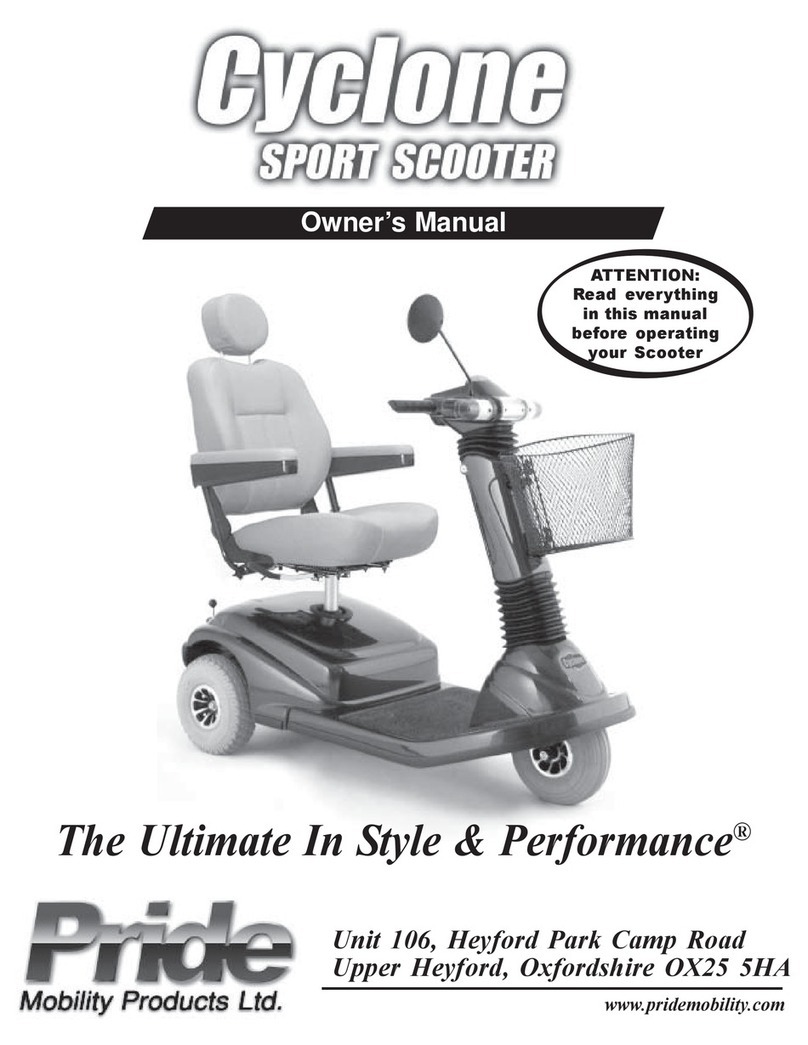
Pride Mobility
Pride Mobility The Ultimate In Style & Performance owner's manual
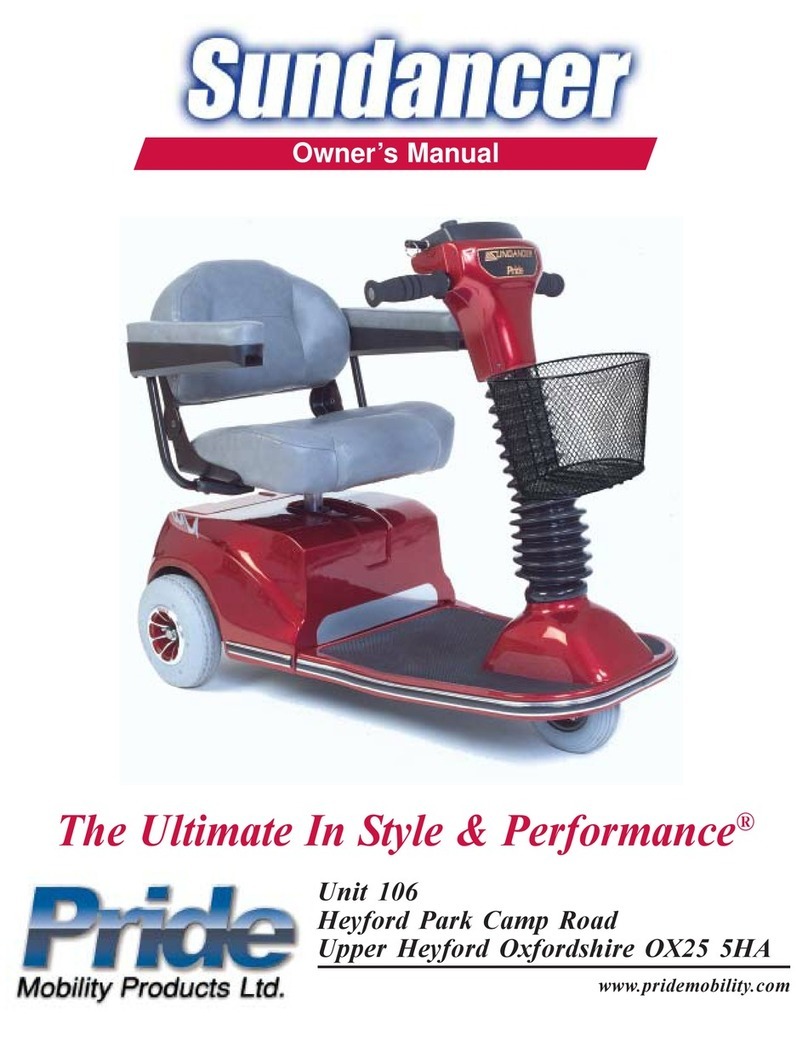
Pride
Pride Sundancer owner's manual

Nils Extreme
Nils Extreme HA200T user manual

Heartway Medical Products
Heartway Medical Products S33 user manual

Roma Medical
Roma Medical Murcia user manual
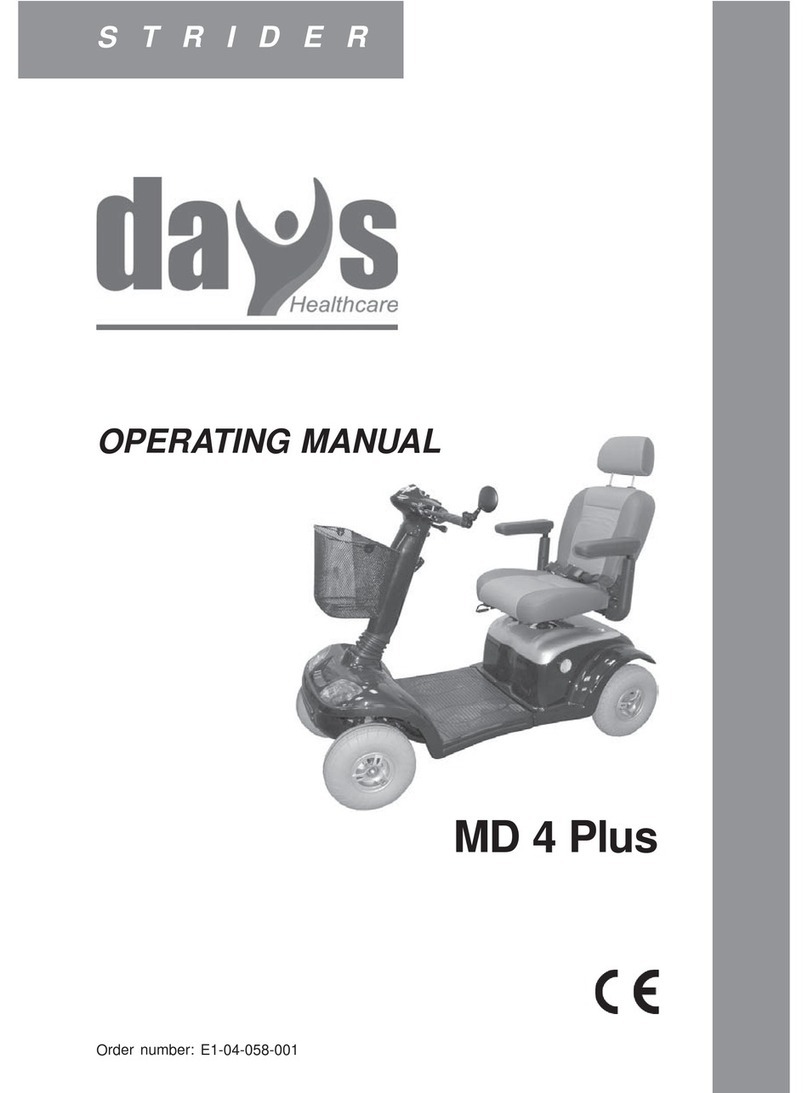
Days
Days MD 4 Plus operating manual
